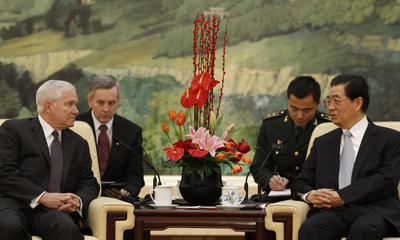I participated in the project, which included workshops with Chinese specialists assembled by Peking University. I also wrote the report’s chapter on Central Asia.
The project is interesting because the US and China actually have a long history of cooperating in places along China’s border. Just take recent tensions over Afghanistan, for example. These strains belie the degree to which Beijing and Washington worked jointly to defeat the Soviet occupation of Afghanistan in the 1980s. Washington encouraged Chinese support for the Afghan mujahideen, and the two countries cooperated in other unprecedented ways during the conflict.
But that was then.
Today, the US and China are often at loggerheads in such places. US officials have argued that Chinese policies help to bolster Myanmar’s ruling junta. Many in Washington argue, too, that Chinese policies have shielded North Korea from the effects of international sanctions that Beijing itself has repeatedly voted for.
For their part, Chinese officials often view US policies in these countries as naïve at best, destabilising at worst. Many in Beijing hold the view that US and South Korean ‘failures’ have cornered North Korea and thus urge deepened policies of engagement. In Central Asia, meanwhile, as Deputy Assistant Secretary of State for the region in 2006 and 2007, I heard Chinese officials argue ad infinitum that US actions to promote political reform could, ultimately, destabilise these countries.
What’s going on? Does cooperation really have to be so hard? For that matter, is coordination so hard because the US and China lack common interests?
I think not. In fact, asserting so is a too-easy cop out because, in most cases, it would be awfully hard to demonstrate empirically that China actually ‘wants’ an unstable Pakistan or would just ‘love’ a North Korea with nuclear weapons. In the countries at the heart of this CFR study, why wouldn’t China share America’s interest in stability, security, development and prosperity?
No, I suspect the problem usually isn’t a lack of common interests. It’s that shared interests are very general in nature. Turning (abstract) common interests into (concrete) complementary policies requires that Beijing and Washington overcome two very high hurdles:
First, Beijing almost never seems to share American threat assessments anymore. Countries like Iran and North Korea don’t threaten China directly, so Beijing can probably afford to be more relaxed and many Chinese analysts argue that Washington overstates the scope and urgency of such threats.
Second, even when Beijing shares America’s sense of threat, countervailing interests still obstruct cooperation. In Afghanistan, for example, China certainly shares America’s core interest: a stable Afghan state that does not harbour, nurture or export terrorism. But Chinese decision-makers have become uncomfortable when told that the path to victory may require a long-term NATO presence on China’s western border, US bases and access agreements in Central Asia, and enhanced US and NATO strategic coordination with neighbours that have had difficult relations with China.
So, what’s to be done? More dialogue, perhaps? I’m sceptical.
Dialogue, in itself, is not a policy, not least because dialogue for its own sake has not, in the recent past, proved especially useful. The US and China have held routine dialogue on Central Asia since at least 2006. An institutionalised Central Asia sub-dialogue was established in December 2005 in the wake of a meeting of the US-China Senior Dialogue in Washington. But the quality of the conversations has been mixed and few, if any, coordinated actions have emerged from it.
Here, then, are a few bottom lines:
First, since coordination has been weak, the US and China should aim at complementary, but not necessarily joint, projects and actions. Of course the US and China need, in the first instance, to establish more transparency and a better mutual understanding of each other’s strategic intentions. But both countries are active, for example, with capacity-building programs and projects. So it is important to remember that complementary projects and actions need not be conducted jointly.
One example is counter-narcotics work, where Washington and Beijing could coordinate their areas of focus, direct their respective financial assistance packages at similar drugs-related goals, and build complementary capacity while maintaining separate efforts.
Second, of course the two countries should aim to improve coordination, but they shouldn’t expect to do real joint contingency planning. Not anytime soon, in any case. US-China coordination will continue to be difficult for the various reasons noted above: China does not often share American threat assessments; China does not support the US approach to political or economic reform in, say, Central Asia or Pakistan; and finally, countervailing interests, clashing security concepts, and mutual suspicions will remain an obstacle for some time.
That means contingency discussions of, for example, donor principles and modalities in a prospective food crisis — in Central Asia or North Korea, for example — could build a better platform for US-China coordination than, say, aiming high at the big security issues.
Third, to use an American football metaphor: the two countries don’t always have to ‘throw long’. Working now on peripheral issues may well give both countries a better chance to work over time toward core strategic issues. My bet is that coordinating economic policies will prove easier than coordinating security policies. And coordinating with ad hoc groups — for instance, with the Asian Development Bank’s Central Asia Regional Economic Cooperation program — will provide China with some ‘cover’, and thus prove easier than coordinating bilaterally.
At the end of the day, the US and China badly need to create a track record of concrete successes. And this is especially true in the places where shared strategic interests exist but remain awfully abstract.
Evan A Feigenbaum is Adjunct Senior Fellow for East, Central and South Asia at the Council on Foreign Relations. A version of this article was first published here at the Council on Foreign Relations.


Very good and insightful opinion piece!